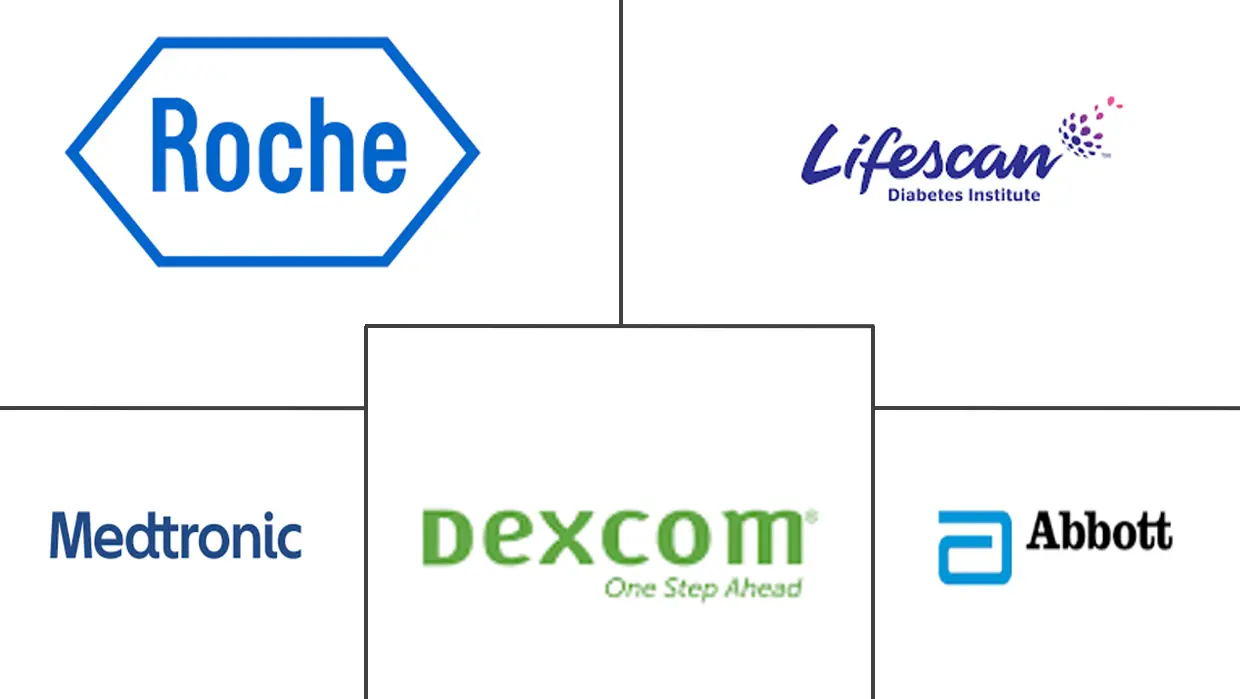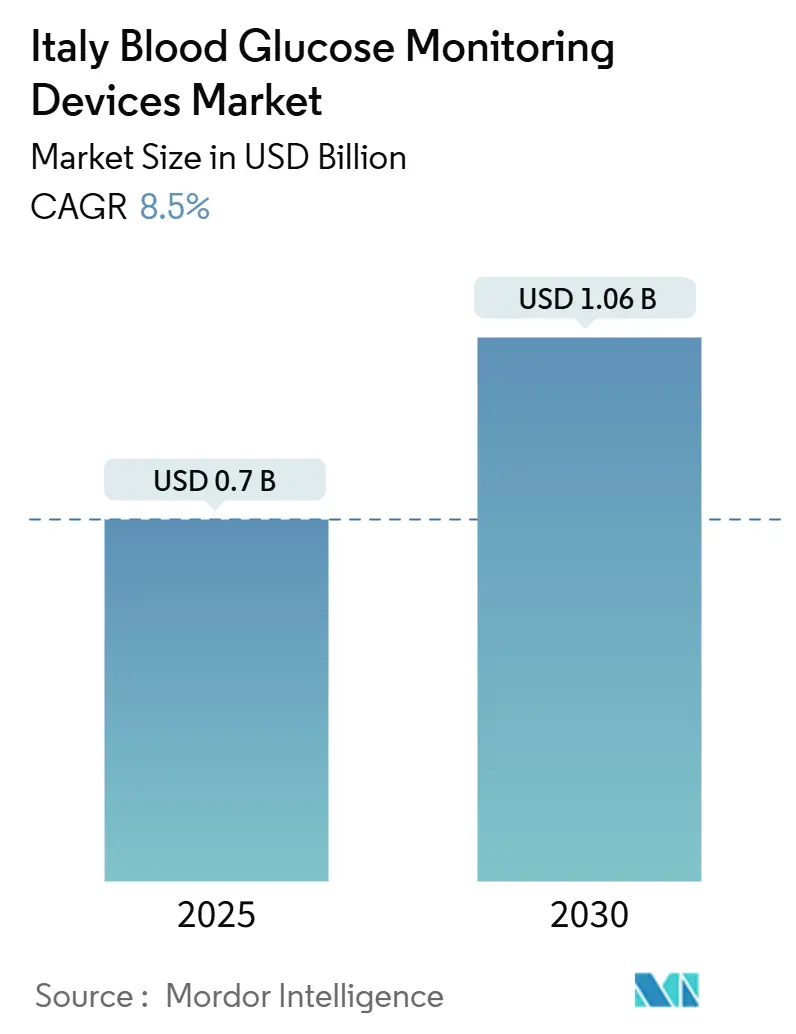
Italy Blood Glucose Monitoring Devices Market Analysis by Mordor Intelligence
The Italy Blood Glucose Monitoring Devices Market size is estimated at USD 0.7 billion in 2025, and is expected to reach USD 1.06 billion by 2030, at a CAGR of 8.5% during the forecast period (2025-2030).
The increasing number of diabetes cases in Italy is driving the growth of the market for blood glucose monitoring devices over the forecast period. Diabetes, a chronic disease characterized by high blood sugar levels, has become a significant health concern in Italy, with an increasing number of individuals being diagnosed with the condition. This surge in diabetes cases has created a demand for effective and efficient blood glucose monitoring devices to help individuals manage their condition.
Blood glucose monitoring devices play a crucial role in diabetes management by enabling individuals to regularly monitor their blood sugar levels. These devices provide accurate and real-time readings, enabling individuals to make informed decisions about their diet, medication, and lifestyle choices. With the rising prevalence of diabetes in Italy, there is a growing need for these devices to help individuals maintain optimal blood sugar levels and prevent complications associated with the disease.
The Italian market for blood glucose monitoring devices is expected to experience significant growth in the forecasted period due to several factors. Firstly, the increasing awareness about diabetes and its management among the general population has led to a higher demand for blood glucose monitoring devices. Individuals are becoming more proactive in monitoring their health and are seeking reliable and user-friendly devices to assist them in managing their diabetes effectively.
Additionally, the increasing geriatric population in Italy, who are more susceptible to developing diabetes, has contributed to the growth of the market. As the elderly population continues to grow, there is a higher demand for blood glucose monitoring devices to cater to their specific needs and ensure effective diabetes management.
Furthermore, government initiatives and healthcare policies aimed at promoting diabetes awareness and prevention have also played a significant role in driving the market growth. These initiatives have increased the accessibility and affordability of blood glucose monitoring devices, making them more widely available to individuals with diabetes.
In conclusion, the rising number of diabetes cases in Italy has fueled the growth of the market for blood glucose monitoring devices in the forecasted period. Factors such as increasing awareness, technological advancements, the growing geriatric population, and government initiatives have contributed to the expansion of the market. As the prevalence of diabetes continues to rise, the demand for blood glucose monitoring devices is expected to further increase, creating opportunities for manufacturers
Italy Blood Glucose Monitoring Devices Market Trends and Insights
Increasing Type-1 diabetes population across Italy
Diabetes mellitus affected nearly 3.8 million Italians in the current year. This was a significant increase from 2010 when 2.9 million people were affected by the disease. Over the ten years under consideration, the number of cases fluctuated along a general upward trend before peaking in 2022. The number of cases was proportional to the age of the patients. Diabetes was, in fact, much more common among the elderly than among the younger.
Diabetes mellitus will affect approximately 1.9 million people aged 65 to 74 and approximately 1.6 million aged 75 and up in Italy in 2022. Diabetes poses several challenges for both the NHS and Italian society. The greatest challenge is the rising prevalence of diabetes, which poses real health and economic threat to the Italian health system in the future. Prevalence has steadily increased over the last decade and is expected to rise further. It has been stated that if prevalence continues to rise at this rate, the future impact on society and the economy will be unsustainable.
The aging population and rising obesity are major contributors to rising prevalence. If an aging population is difficult. Obesity has increased in recent years, as evidenced by the AMD Annals, owing primarily to unhealthy lifestyle choices such as poor diet and insufficient physical activity. Obesity is so closely linked to diabetes that the two conditions have been dubbed "diabesity controlling." Meeting the demand for diabetes care is becoming increasingly difficult as diabetes prevalence rises, with diabetes centers struggling to care for an increasing number of diabetic patients even though diabetes centers are geographically distributed evenly.
About 10% of the Italian population has diabetes as of 2022. The rate of newly diagnosed Type 1 and Type 2 diabetes cases is seen to increase, mainly due to obesity, unhealthy diet, and physical inactivity. The rapidly increasing incidence and prevalence of diabetic patients and healthcare expenditure are indications of the increasing usage of diabetic care products.
In May 2022, the World Health Assembly agreed on a Resolution on strengthening the prevention and control of diabetes. It recommends action in areas including increasing access to insulin, promoting convergence and harmonization of regulatory requirements for insulin and other medicines and health products for the treatment of diabetes, and assessing the feasibility and potential value of establishing a web-based tool to share information relevant to the transparency of markets for diabetes medicines and health products.
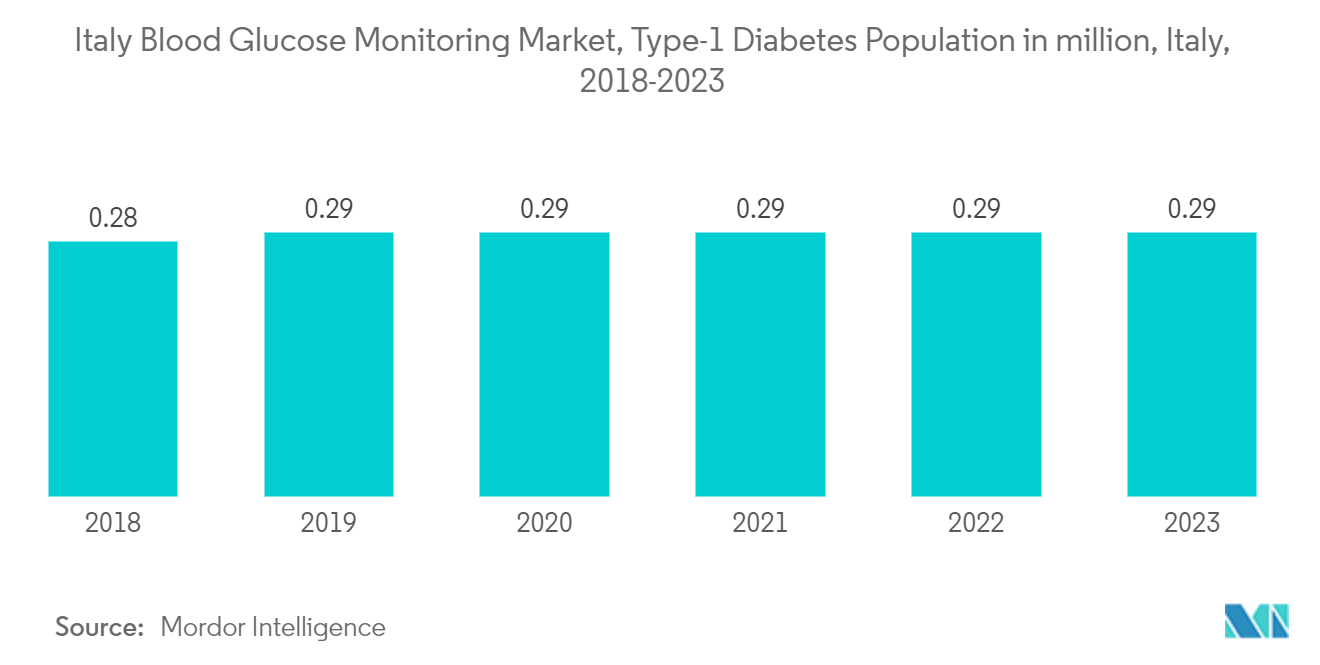
Continuous Glucose Monitoring Holds Highest CAGR in Italy Blood Glucose Monitoring Devices Market.
The COVID-19 pandemic emphasized the need for good glycemic control in patients with diabetes, largely because most observational studies have reported that poorly controlled diabetes is associated with a higher risk of hospitalization and death from a viral illness. The frequency of monitoring glucose levels depends on the type of diabetes, which varies from patient to patient. Type-1 diabetic patients need to check their blood glucose levels regularly to monitor their blood glucose levels and adjust the insulin dosing accordingly.
The current CGM devices show a detailed representation of blood glucose patterns and tendencies compared to a routine check of glucose levels at set intervals. Furthermore, the current continuous glucose monitoring devices can either retrospectively display the trends in blood glucose levels by downloading the data or give a real-time picture of glucose levels through receiver displays.
The use of CGM by Type-1 diabetic patients is very less as compared to Type-2 diabetic patients. But the expenditure of Type-1 diabetic patients on these devices is nearly double that of Type-2 diabetics. The newest CGM models, the Abbott Freestyle Libre and the Dexcom G6, overcame many technical barriers. However, high costs and uncertainties about their efficacy and necessity have kept CGM from being widely used by people with Type-2 diabetes. Continuous glucose monitoring devices are becoming cheaper with new technologies, like cell phone integration.
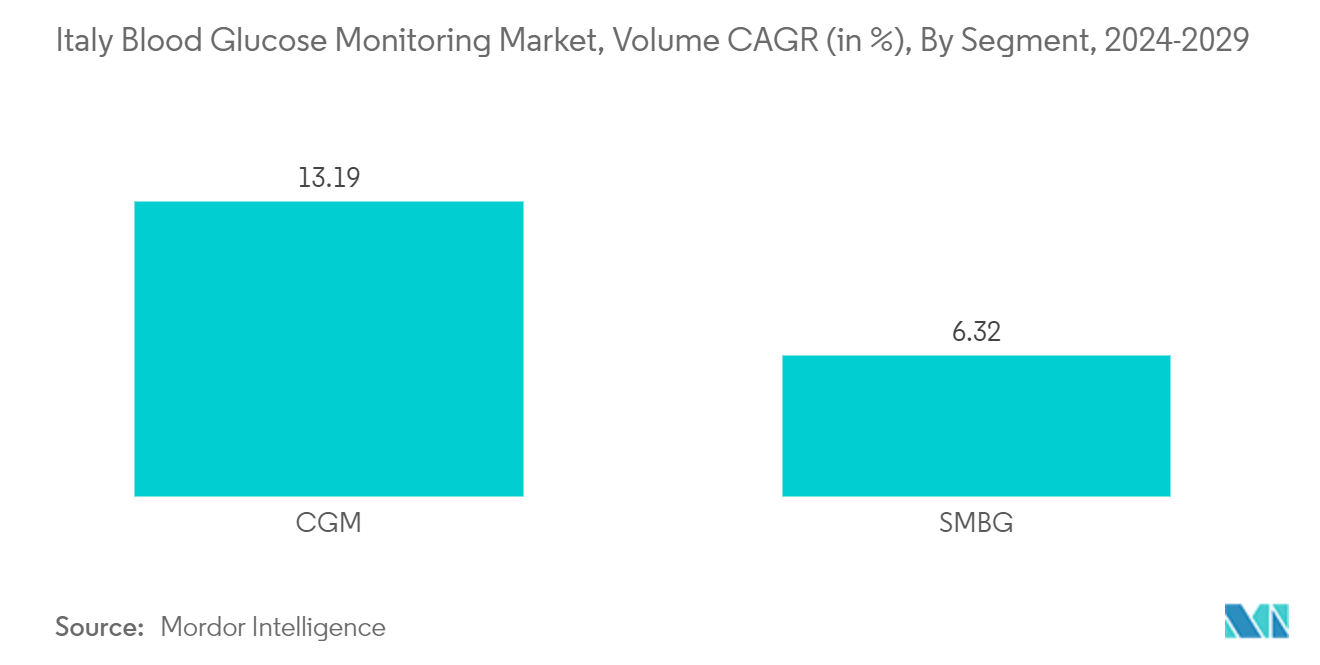
Competitive Landscape
The blood glucose monitoring device market is highly fragmented, with few major manufacturers present in the market. The CGM devices market is dominated by major players like Dexcom, Medtronics, Abbott, and Senseonics. The market for BGM devices comprises more generic players like Roche, LifeScan, Arkray, Ascensia, etc. Technological innovations in the recent past helped companies to strengthen their market presence.
Italy Blood Glucose Monitoring Devices Industry Leaders
-
Roche
-
Abbott
-
Dexcom
-
Medtronics
-
LifeScan
- *Disclaimer: Major Players sorted in no particular order
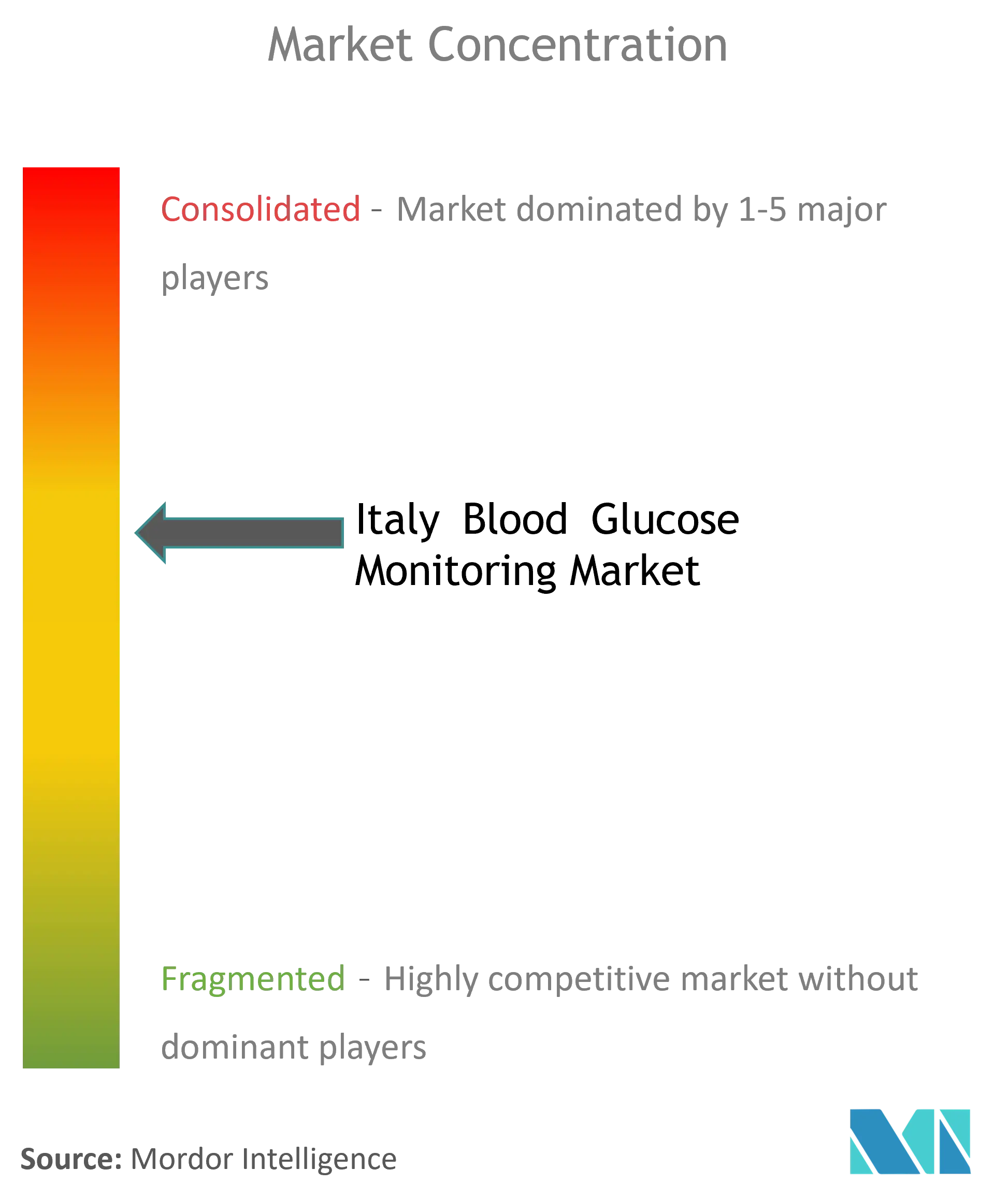
Recent Industry Developments
- October 2023: Medtronic's Simplera is the most recent continuous glucose monitor (CGM) designed for individuals aged 2 and above who have diabetes. Currently undergoing FDA evaluation for approval in the United States, Simplera is an elegant, disposable device that eliminates the need for fingersticks. In Europe, Medtronic's latest CGM, Simplera, has already received approval.
- March 2022: DexCom announced the receipt of a CE Mark for its G7 CGM system in Europe, intended for people who have diabetes and are two years and older, including pregnant women. With this approval, the highly popular and best-selling real-time CGM in the world is now more powerful and easier to use with a small, all-in-one wearable and completely redesigned mobile app.
Italy Blood Glucose Monitoring Devices Market Report Scope
Italy Blood Glucose Monitoring Devices Market witnessed USD 0.5 billion in the current year and is anticipated to register a CAGR of over 5% during the forecast period. Italy Blood Glucose Monitoring Devices Market is segmented into Type (Self-monitoring Blood Glucose and Continuous Glucose Monitoring), Component (Glucometer Devices, Test Strips, Lancets, Sensors, and Durables). The report offers the value (in USD million) and volume (in Units million) for the above segments.
| Glucometer Devices |
| Test Strips |
| Lancets |
| Sensors |
| Durables (Receivers and Transmitters) |
| Self-monitoring blood glucose devices | Glucometer Devices |
| Test Strips | |
| Lancets | |
| Continuous blood glucose monitoring devices | Sensors |
| Durables (Receivers and Transmitters) |
Key Questions Answered in the Report
How big is the Italy Blood Glucose Monitoring Devices Market?
The Italy Blood Glucose Monitoring Devices Market size is expected to reach USD 0.70 billion in 2025 and grow at a CAGR of 8.5% to reach USD 1.06 billion by 2030.
What is the current Italy Blood Glucose Monitoring Devices Market size?
In 2025, the Italy Blood Glucose Monitoring Devices Market size is expected to reach USD 0.70 billion.
Who are the key players in Italy Blood Glucose Monitoring Devices Market?
Roche, Abbott, Dexcom, Medtronics and LifeScan are the major companies operating in the Italy Blood Glucose Monitoring Devices Market.
What years does this Italy Blood Glucose Monitoring Devices Market cover, and what was the market size in 2024?
In 2024, the Italy Blood Glucose Monitoring Devices Market size was estimated at USD 0.64 billion. The report covers the Italy Blood Glucose Monitoring Devices Market historical market size for years: 2019, 2020, 2021, 2022, 2023 and 2024. The report also forecasts the Italy Blood Glucose Monitoring Devices Market size for years: 2025, 2026, 2027, 2028, 2029 and 2030.
Page last updated on:
